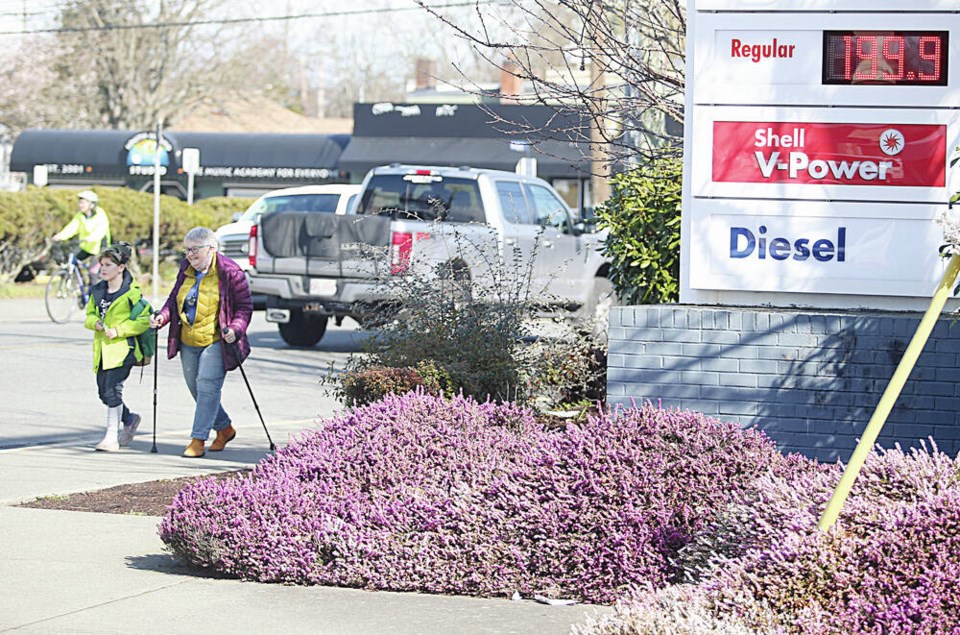The price of gas dipped below $2 a litre in many locations in the capital region Wednesday, but remains volatile as Canada’s inflation rate hits a 30-year high.
The annual rate of inflation climbed to 5.7 per cent in February, reaching the highest level since August 1991 and the second straight month it has been above five per cent, Statistics Canada said Wednesday.
Earlier this month, the price for one litre of regular fuel spiked to $2.169 a litre in Sooke, although many service stations were selling at $2.089.
Werner Antweiler, a University of B.C. business professor studying international trade and gas prices, said energy prices are by far the most volatile of consumer goods affected by rising inflation. The war in Ukraine drove the price of oil up to $120 per barrel, although that’s since dropped to below $100 per barrel as the market seeks a new equilibrium.
Oil is traded for months and even years into the future. The market anticipates a lower price level at some point because there is still spare capacity among suppliers, Antweiler said.
High energy costs help push up prices for goods, since energy is needed for processing, manufacturing and delivering goods to markets. “We see that anything that’s energy intensive will also have to pass on the higher cost to consumers,” Antweiler said.
Some of the latest uptick in consumer prices is actually a catch-up after a drop due to the pandemic, he said.
Tu Nguyen, a Toronto-based economist with accounting firm RSM Canada, said inflation is expected to be closer to six per cent in March and could even reach seven per cent for the first time since the early 1980s.
“Just be ready for inflation this year to stay high,” she said. “It’s going to be difficult.”
Helping to drive the increase in February were the higher gasoline prices, up 32.3 per cent compared with February 2021 and up 6.9 per cent from January. Excluding gas prices, the annual inflation rate would have been 4.7 per cent in February.
Grocery-store prices were up 7.4 per cent for the largest yearly increase since May 2009, pushed higher by rising fuel costs that are being passed on to shoppers.
Shelter costs, which include prices for homes and rental units, rose at their fastest pace since August 1983. BMO chief economist Douglas Porter said the 4.2 per cent year-over-year increase for rents was a byproduct of the raging housing market where prices continue to rise.
Although groceries and gasoline grabbed headlines, RBC economist Rannella Billy-Ochieng noted that prices for two-thirds of the basket of goods used to calculate inflation rose faster than the central bank’s two per cent target in February.
The 5.7 per cent reading for inflation follows the jobs report last week by Statistics Canada that found average hourly wages in February rose 3.1 per cent compared with one year earlier.
“If it feels like everything is getting more expensive, it’s because it is,” said Royce Mendes, managing director and head of macro strategy at Desjardins.
Prices for some of the key drivers of inflation in February are likely to go higher this month, especially for gasoline, as global oil prices rise in line with uncertainty around Russia’s unprovoked invasion of Ukraine. Gasoline prices on Tuesday were 11 per cent higher than at the end of February, Mendes said.
Two weeks ago, the Bank of Canada raised its key policy rate to 0.5 per cent, marking the first hike since cutting rates two years ago, and warned of more hikes to come to rein in inflation and bring it back to the central bank’s target zone of between one and three per cent. Including last month, inflation has spent 11 consecutive months above that zone.
The average of the three measures for core inflation, which are considered better gauges of underlying price pressures and closely tracked by the Bank of Canada, was 3.5 per cent for February, pointing to more pervasive and broad-based pressure on prices that has left the central bank uneasy about inflation.
The February average was the highest rate recorded since June 1991.
Even if the global drivers of inflation start to cool, domestic pressures may ramp up in their place. Mendes said further easing of public health restrictions could see increases in prices for services.
“Even as the headline inflation rate is likely to decelerate, beginning in the second quarter and over the course of the year, it’s likely the Bank of Canada will continue increasing interest rates to fight off those underlying, homegrown inflationary pressures,” he said.
Pressure is building on the federal Liberal government to not add fuel to the inflationary fire with its budget expected in the coming weeks. On Thursday, the Conservatives called on the government to chart a path to balance the budget, while NDP Leader Jagmeet Singh used an event in Brampton, Ont., to call for a tax on corporate profits.
cjwilson@timescolonist.com
— With The Canadian Press


